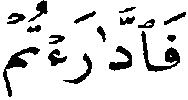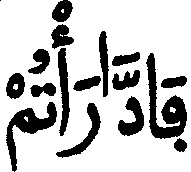|
Part 2: The True State Of The Qur’an The additional four are: b/ Several Of These ‘Readings’ Are Still In Print Today Although it is not readily apparent to Westerners, at present there are several ‘readings’ of the Qur’an in print among the Islamic peoples. For our purpose we will examine two of these, namely, those purported to be of Warsh ‘an (according to) Nafi (d. 169 A.H.), and Hafs ‘an ‘Asim (d. 127 A.H.). As just noted, Nafi and ‘Asim were living at Medinah and Kufah respectively. Thus, one would expect to find that the ‘Uthmanic consonantal symbol texts underlying their ‘readings’ should indicate what errors these ‘Uthmanic texts contained. As to the present use of these texts, Von Denffer relates: "...the reading transmitted by Warsh is widespread in Africa, except Egypt, where, as now in almost all other parts of the Muslim world, the reading transmitted by Hafs is observed." (Ulum, p.119, emphasis added).3 c/ ‘Expected’ Variations Between The Hafs and Warsh ‘Readings’ As one would expect, between two differing ‘readings’4 there are variations in vowelling, obtained by the varying application of the short vowel signs of fatha And Von Denffer openly acknowledges vowelling differences, underscoring his photographic Plates 7 and 8 with the comments: "A page from a printed Qur’an from North Africa...The text is vowelled according to the reading of Warsh." and "A page from a printed Qur’an from Jordan. The text is vowelled according to the reading of Hafs." (Ulum, rear of book; emphasis added). However, Von Denffer does not provide any examples of the other type of variation one would expect to find between the Hafs and Warsh ‘readings’, namely variations in consonants obtained through the use of different combinations of the diacritical dots. These are what indicate which consonant the original ‘consonantal symbol’ is to represent. Such variations are plentiful. A few follow: 37 |
 ) / nunshiruhA (
) / nunshiruhA (  ) - [Hafs has waw {= ‘and’}, which is omitted in the Warsh (Medinan) text.].10
) - [Hafs has waw {= ‘and’}, which is omitted in the Warsh (Medinan) text.].10  ) / (
) / (  ) - [The alif is omitted in the Hafs (Kufan) text but is present in the Warsh (Medinan) text.].
) - [The alif is omitted in the Hafs (Kufan) text but is present in the Warsh (Medinan) text.].  ) / (
) / ( ) - [The Hafs (Kufan) text omits the nun, which is present in the Warsh (Medinan) text.]
) - [The Hafs (Kufan) text omits the nun, which is present in the Warsh (Medinan) text.]  ) - [The Hafs (Kufan) text omits the nun, which is present in the Warsh (Medinan) text.].
) - [The Hafs (Kufan) text omits the nun, which is present in the Warsh (Medinan) text.].